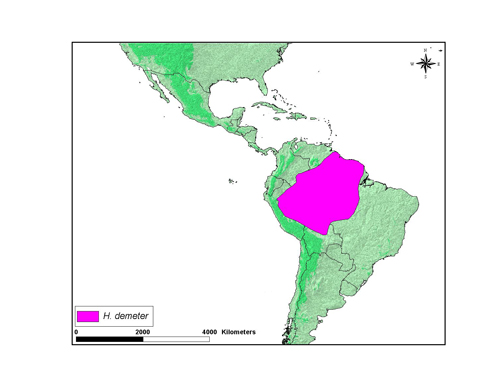Heliconius demeter
Margarita BeltránIntroduction
Etymology: Demeter is the Greek earth goddess, who brings forth the fruits of the earth, particularly the various grains. She taught mankind the art of sowing and ploughing so they could end their nomadic existence. As such, Demeter was also the goddess of planned society. She was very popular with the rural population. As a fertility goddess she is sometimes identified with Rhea and Gaia (Demeter).
Characteristics
Early stages: Eggs are yellow and approximately 1.3 x 0.7 mm (h x w). Females usually place 1 to 15 eggs on growing shoots of the host plant. Mature larvae have a yellow body with black spots or bands, and whit black scoli and head; length is around 2 cm. Caterpillars are gregarious (Brown, 1981).
Geographical Distribution
Heliconius demeter is distributed in the Amazon Basin. The map below shows an approximate representation of the geographic distribution of this species. The original data used to draw these maps is derived from Brown (1979) which is available at Keith S. Brown Jr. (1979). Ecological Geography and Evolution in Neotropical Forests .
Habits
H. demeter occurs from sea level to 1,100 m in sand forest. The males sit on female pupae a day before emergence, and mating occurs the next morning, before the female has completely eclosed. Adults roost at night in loose groups 2-10 m above ground and under leaves (Brown, 1981).
Host plant: H. demeter larvae feed primarily on plants from the genera Dilkea and Mitostemma (Brown, 1981).
References
Brown K. S. 1981 The Biology of Heliconius and Related Genera. Annual Review of Entomology 26, 427-456.
"Demeter." Encyclopedia Mythica from Encyclopedia Mythica Online. http://www.pantheon.org/articles/d/demeter.html [Accessed May 22, 2008].
Staudinger O. 1897. Neue Heliconius-Arten und Formen. Deutsche entomologische Zeitschrift "Iris" 9(2): 284-317, pls. 6-7.
Title Illustrations

| Scientific Name | Heliconius demeter ucayalensis |
|---|---|
| Specimen Condition | Dead Specimen |
| View | Dorsal |
| Collection | Gerardo Lamas |
| Image Use |
 This media file is licensed under the Creative Commons Attribution-NonCommercial-ShareAlike License - Version 3.0. This media file is licensed under the Creative Commons Attribution-NonCommercial-ShareAlike License - Version 3.0.
|
| Copyright |
©

|
| Scientific Name | Heliconius demeter ucayalensis |
|---|---|
| Specimen Condition | Dead Specimen |
| View | Ventral |
| Collection | Gerardo Lamas |
| Image Use |
 This media file is licensed under the Creative Commons Attribution-NonCommercial-ShareAlike License - Version 3.0. This media file is licensed under the Creative Commons Attribution-NonCommercial-ShareAlike License - Version 3.0.
|
| Copyright |
©

|
About This Page

University of Cambridge, Cambridge, UK
Correspondence regarding this page should be directed to Margarita Beltrán at
Page copyright © 2010
 Page: Tree of Life
Heliconius demeter .
Authored by
Margarita Beltrán.
The TEXT of this page is licensed under the
Creative Commons Attribution-NonCommercial-ShareAlike License - Version 3.0. Note that images and other media
featured on this page are each governed by their own license, and they may or may not be available
for reuse. Click on an image or a media link to access the media data window, which provides the
relevant licensing information. For the general terms and conditions of ToL material reuse and
redistribution, please see the Tree of Life Copyright
Policies.
Page: Tree of Life
Heliconius demeter .
Authored by
Margarita Beltrán.
The TEXT of this page is licensed under the
Creative Commons Attribution-NonCommercial-ShareAlike License - Version 3.0. Note that images and other media
featured on this page are each governed by their own license, and they may or may not be available
for reuse. Click on an image or a media link to access the media data window, which provides the
relevant licensing information. For the general terms and conditions of ToL material reuse and
redistribution, please see the Tree of Life Copyright
Policies.
- First online 18 February 2007
- Content changed 12 August 2008
Citing this page:
Beltrán, Margarita. 2008. Heliconius demeter . Version 12 August 2008 (under construction). http://tolweb.org/Heliconius_demeter/72946/2008.08.12 in The Tree of Life Web Project, http://tolweb.org/







 Go to quick links
Go to quick search
Go to navigation for this section of the ToL site
Go to detailed links for the ToL site
Go to quick links
Go to quick search
Go to navigation for this section of the ToL site
Go to detailed links for the ToL site